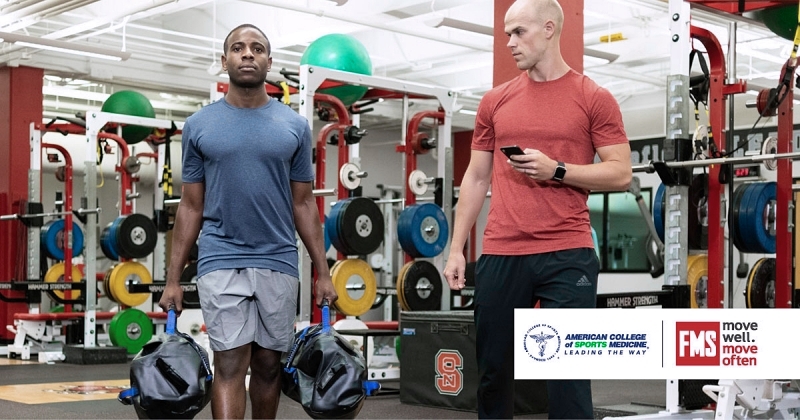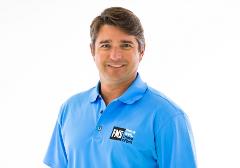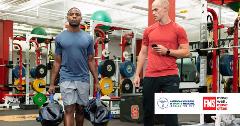Lee Burton, Ph.D., ATC |
Dec.
19, 2019

Functional Movement Systems (FMS) and ACSM recently hosted an industry-presented webinar with Lee Burton, PhD, ATC, entitled Secrets to Enhancing Shoulder Strength and Function. This is Part II of the Q&A.
Read Part I of the Q&A here.
Several questions were asked by attendees during the webinar and the answers pertaining to the rotator cuff, thoracic spine mobility, and more are below.
Q: What kind of exercises do you recommend for somebody with Scheuermann's kyphosis?
Utilize the quadruped rotations that were shown in the presentation, focus on the tighter side. The key would be to also focus on other patterns like squatting, lunging and ensure they are not getting worse. So not just focusing on the mid-back, but also making sure other movements are at least acceptable and can work those patterns, like split squats and forward single arm presses.
Q: What is the best exercise to strengthen an injured rotator cuff pre-surgery? Post?
Keep it simple, push-ups, pull-ups, deadlifts (single-arm) and farmer’s walks.
Q: How do you apply this to the older adult population (65+) who are not able to perform a lot of these movements/screenings?
There are a variety of ways to incorporate some of these activities with older adults. For example, a simple idea would be to try using a matt table.
Q: What are your thoughts on overhead exercises where you're sitting on the floor with your feet out front like with a Z-press for correcting shoulder dysfunctions?
I believe you should avoid loaded presses in a seated position, these are better performed standing or half-kneeling.
Q: If we detect an upper crossed syndrome and thoracic stiffness, do we have to eliminate all overhead movements until the problem is fixed?
Not necessarily, just focus on more one arm activities or half-kneeling/standing split stance push/pull activities with a cable system.
Q: What do you do to work on kyphosis?
Start on the ground doing crawling, quadruped rotations, etc. focus on the tighter side.
Q: What do you do for functional movement with someone with double knee replacement that can’t bend down?
There are quite a few things that can be done. For example, try working on single-leg balance toe-touching, deadlifting, etc.
Q: Are there benefits to static stretching for shoulder health, if so, what are they?
Sure, static stretching for shoulder health is more based on the individual and what the underlying issues are.
Q: Are there any benefits to doing rotator cuff exercises such as internal/external movements and which do you recommend for healthier shoulders?
I don’t believe it is necessary unless there is a medical problem with the shoulder/rotator cuff. Focus more on stability activities such as deadlifts and farmer’s walks, these are better activities for stability.
Q: What is the best method to improve shoulder external rotation?
First focus on mid-back/t-spine mobility, which most often is the problem. Most people have limitations in shoulder internal rotation and not external rotation.
Q: I'm a PT and know how to treat shoulder impingement in the clinic, but do you have any tricks to combat impingement in the gym (without the manual therapy for ex. Mobilizations)?
Have people focus on getting and maintaining thoracic spine mobility through some of the techniques I reviewed and ensure good postural control when performing lifts. Poor technique is the primary cause of shoulder problems when lifting.
Q: How do you implement some of these movements with morbidly obese patients? What special considerations need to be taken?
In my opinion, the focus should be on general mobility and body weight activities and not worrying about isolating any one thing. Working on increasing their overall activity level, keep it simple and slowly progress.
Q: Are these breathing focused stretches OK for someone who has asthma, kyphosis and poor cervical and thoracic mobility?
Yes, I definitely recommend breathing focused stretches for these individuals.
Q: What is the best way to train the rotator cuff muscles?
Ensure the client has good mid-back mobility, postural control, and focus more on stability activities such as deadlifts and, farmer’s walks as these are better activities for stability.
Q: With a client that has very poor movements but is also very overweight, what type of movements do you recommend, or do you have a strategy to correct both?
In my opinion, the focus should be on general mobility and body weight activities and not on worrying about isolating any one thing. Working on increasing the client’s overall activity level is key. Keep it simple and slowly progress.
Q: You mentioned that the overall role for the rotator cuffs was to stabilize the joint. Should you focus on strengthening the muscle specifically in order to protect the shoulder?
I don’t believe it is necessary unless there is a medical problem with the shoulder/rotator cuff. Focus more on stability activities such as deadlifts and farmer’s walks as these are better activities for stability.
Presenter:

Dr. Lee Burton has an extensive background in sports medicine and strength and conditioning. He currently consults with a wide variety of professional sports organizations as well as leading health and fitness facilities on injury prevention and performance enhancement. He lectures both nationally and internationally on various topics in the fields of sports medicine and strength and conditioning. Dr. Burton is a Certified Athletic Trainer, Certified Strength and Conditioning Specialist and one of the founding owners of Functional Movement Systems.
View More Popular FMS Content

CEC Course | FMS - Move Well then Move Often

Secrets to Enhancing Shoulder Strength and Function Q&A Part I